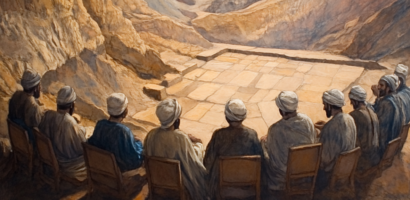The Robe of Jesus the High Priest (by Eli Lizorkin-Eyzenberg and Peter Shirokov)
13 … I saw one like a son of man, clothed in a robe reaching to the feet, and girded across His chest with a golden sash.
The description of the Son of Man’s clothing is consistent with his priestly duties (though different from the Aaronic priesthood). A robe reaching to the feet and a sash were both prescribed for priests in the Mosaic tabernacle (Ex.28). In addition we read in Lev. 16:3-4:
“Aaron shall enter the holy place with this: with a bull for a sin offering and a ram for a burnt offering. He shall put on the holy linen tunic, and the linen undergarments shall be next to his body, and he shall be girded with the linen sash and attired with the linen turban (these are holy garments).”
In Revelation1:13 we read about a robe reaching to the feet and a sash, but we do not read about a white turban. We do, however, read in vs.14 that his head (and then separately his hair) is described in terms of white wool. There is some similarity to the high priest’s attire for the Day of Atonement during which, unlike his daily clothing, the High Priest’s clothing was all white. In a much later rabbinic discussion on the function of priestly vestments we read in the Babylonian Talmud, Zevachim 88b:
“R. ‘Inyani b. Sason also said: Why are the sections on sacrifices and the priestly vestments close together? To teach you: as sacrifices make atonement, so do the priestly vestments make atonement. The coat atones for bloodshed… The breeches atoned for lewdness… The mitre made atonement for arrogance. The girdle atoned for [impure] meditations of the heart… The breastplate atoned for [neglect of] civil laws… The ephod atoned for idolatry… The robe atoned for slander… the head plate atoned for brazenness…”
This reference cannot be taken as background information since it was written much later, yet it shows general interpretive trajectories (as with almost everything in the Talmud) that may be traceable to the time of Jesus and before. So at least one thing is clear; Jesus’ heavenly garments are intentional, they are in fact highly symbolic – they show that Jesus is the heavenly priest, fully prepared and qualified to carry out his duties.
There is no reason to expect an exact correlation between the priestly vestments in the Mosaic Tabernacle and those of Jesus. Jesus’ priesthood is decisively of a different order (the order of Melchizedek and not the order of Aaron). Relative correlation can, however, be established and it shows the general idea of Jesus as the heavenly priest.








Q. Why is Jesus pictured in the garb of a Levite High Priest?
Christ was from the tribe of Judah and not a Levite. Christ is a Kingly Priest after the order of Melchizedek. The Levitical priesthood & Mosaic covenant (the ministry of death) was abolished, and a new covenant replaced it.
I am thankful the information and understanding. I never thought there wasn’t anybody God compared JESUS to.
Wow! What a revelation, this is what i have been looking for. Thank you Dr Eli
Welcome to Jewish Studies for Christians, Magauta! Dr. Eli